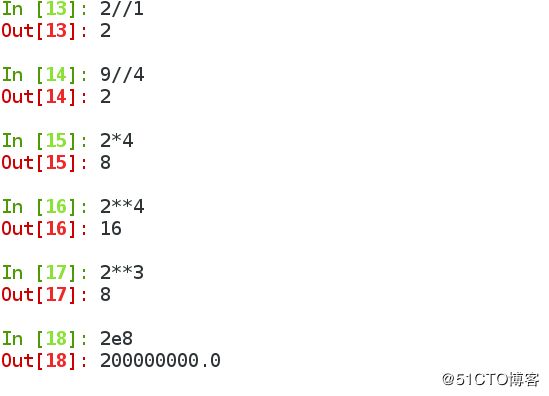一.数值类型
(1)数值类型
整型:1
浮点型:1.0,2e8,2e-8
字符串:"hello"
长整型:111L
布尔类型:True|False
复数类型:complex
(2)运算符
算术运算符:+,-,*,/,%,//(取整)
赋值运算符:+=,—=,/=,%=,=
关系运算符:>,<,<=,>=,==,!= (最终返回结果是bool类型)
(3)逻辑运算符
and,or,not
(4)内置方法(BIF--built-in function)
寻找帮助 help(cmp)
cmp,str,type,int,float,long,complex,bool-----可转化
abs(x) #去绝对值
divmod(x,y) #x/y的商和余数
coerce(x,y) #两数转化为同一类型
round(x) #四舍五入,为浮点型
[root@server code]# ipython
In [1]: 1
Out[1]: 1
In [2]: aInt = 1 #变量名aInt,变量值1
In [3]: type (aInt) #系统自动识别类型
Out[3]: int #整型
In [4]: aFloat = 1.0
In [5]: type(aFloat)
Out[5]: float #浮点型
In [21]: aLong = 1234566666666666666666666666666666
In [22]: type(aLong)
Out[22]: long
In [23]: aLong
Out[23]: 1234566666666666666666666666666666L![]()
In [24]: bLong = 1L
In [25]: type(bLong)
Out[25]: long
In [7]: aBool = True #布尔类型(True,False)
In [9]: type(aBool)
Out[9]: bool #布尔类型
In [26]: aComplex = 1+2j![]()
In [27]: type(aComplex)
Out[27]: complex #复数![]()
In [10]: 1+2 #加法
Out[10]: 3
In [11]: 1-2 #减法
Out[11]: -1
In [13]: 1.0/2 #除法
Out[13]: 0.5
In [1]: 5/2
Out[1]: 2 #取整
In [14]: 2//1 #//取整
Out[14]: 2
In [15]: 9//4
Out[15]: 2
In [28]: 5%2 #取余
Out[28]: 1
In [16]: 2*4 #乘法
Out[16]: 8
In [17]: 2**4 #次方
Out[17]: 16
In [18]: 2**3
Out[18]: 8
In [19]: 2e8 #2x10^8
Out[19]: 200000000.0
In [1]: from future import division #导入未来版本除法
In [29]: aInt = 1 #附值
In [30]: aInt
Out[30]: 1
In [31]: aInt+=1 #加等,相当于aInt=aInt+1
In [32]: aInt
Out[32]: 2
In [33]: aInt %= 3 #取余,aInt=aInt%3
In [34]: aInt
Out[34]: 2
In [35]: 1>2 #判断Ture|False,表达式为真-True,为假-False
Out[35]: False
In [37]: aInt = 1
In [38]: aInt
Out[38]: 1
In [39]: aInt == 1 #比较是否相等,相等为True
Out[39]: True
In [40]: aInt != 1 #比较是否不等
Out[40]: False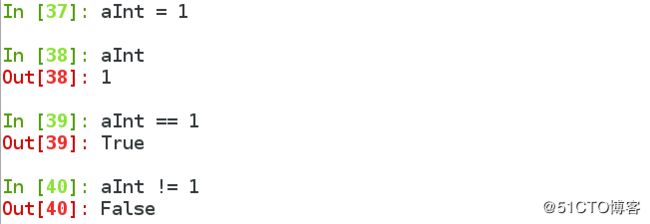
In [41]: 1>2 and 3>4 #逻辑与,一假则假
Out[41]: False
In [42]: 1>3 and 4>2
Out[42]: False
In [43]: 1>2 or 3>1 #逻辑或,见真则真
Out[43]: True
In [44]: 1>2 or 4>5
Out[44]: False
In [45]: True or False
Out[45]: True
In [46]: True
Out[46]: True
In [47]: not True #逻辑非![]()
Out[47]: False
In [48]: not 1<2
Out[48]: False![]()
In [1]: cmp(1,3) #比较大小,前数小于后数,返回值为-1,前数大于后数返回值为1,两数相等返回值为0
Out[1]: -1
In [2]: cmp(3,1)
Out[2]: 1
In [3]: cmp(1,1)
Out[3]: 0
In [4]: help(cmp) #当不清除功能时,使用help()
In [12]: divmod(10,3) #取余数和商
Out[12]: (3, 1)
In [13]: coerce(1+3j,2) #转化为同一类型
Out[13]: ((1+3j), (2+0j))![]()
In [14]: round(1.3) #四舍五入
In [15]: pow(2,3) #求幂次
Out[15]: 8![]()
例:
[root@localhost code1]# vim year.py![]()
#!/usr/bin/env python
#coding:utf-8
"""
判断闰年
这个年份能被4整除但不能被100整除,或者能被400整除,那么就是闰年
"""
year = 2000
print year%400==0 and year%100!=0 or year%400==0

[root@localhost code1]# python year.py
True
![]()
2.IO操作
input:
input:传入值为数值类型
raw_input:传入值为字符串类型
output:
print "hello"
print hello
print """
xxx
"""占位符:%s,%d,%f,%.5d,%.2f,%e
In [2]: print "%d" %(1)
1
In [3]: print "%.5d" %(1)
00001
In [4]: print "%o" %(10) #八进制,满8向前进1
12
In [8]: print "%e" %(1200000000000000000)
1.200000e+18
In [9]: print "%E" %(1200000000000000000)
1.200000E+18
In [10]: print "%f" %(8)
8.000000
In [11]: print "%.2f" %(8)
8.00
[root@localhost code1]# vim code1_01_io.py![]()
#!/usr/bin/env python
#coding:utf-8
"""
I/O:
input
"""
year = input("输入判断年份:")
print type(year)
print year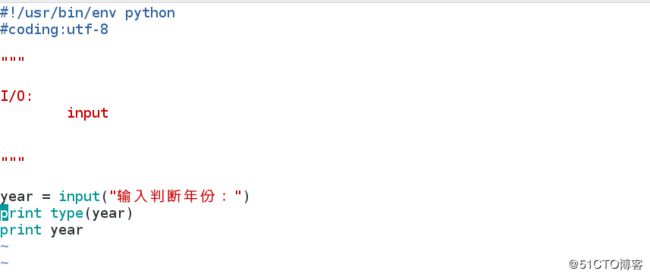
[root@localhost code1]# python code1_01_io.py
输入判断年份:2000
2000
[root@localhost code1]# vim code1_01_io.py![]()
username = raw_input("用户名:")
password = raw_input("密码:")
print "用户名是:", username
print "密码是:", password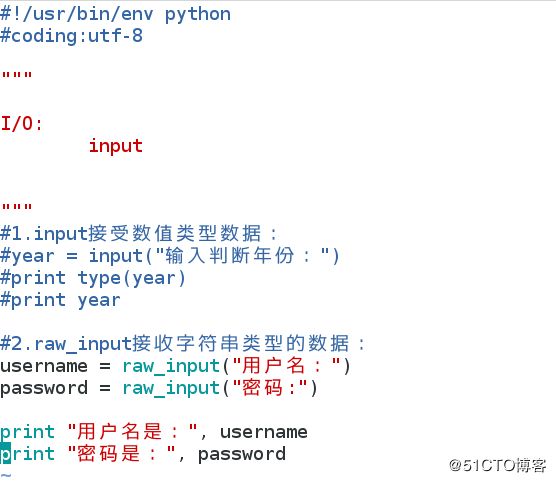
[root@localhost code1]# python code1_01_io.py
用户名:root
密码:redhat
用户名是: root
密码是: redhat
用占位符实现上述:
print "username:%s password:%s" %(username, password)
[root@localhost code1]# python code1_01_io.py
用户名:root
密码:redhat
username:root password:redhat
#3.输出print
(1)编辑器实现
[root@localhost code1]# vim code1_01_io.py![]()
print """ #"""的用法:1.注释一段2.输出一段
**hello***
注册
登陆"""
[root@localhost code1]# python code1_01_io.py
**hello***
注册
登陆#占位符的使用
print "%s %s" %("java", "python")![]()
[root@localhost code1]# python code1_01_io.py
java python![]()
[root@localhost code1]# vim code1_01_io.py![]()
print """
**hello***
%s
%s
"""%("java", "python")
[root@localhost code1]# python code1_01_io.py
(2)交互式实现
[root@localhost code1]# ipython
In [1]: a = """
...: hello
...: 登陆
...: """
In [2]: print a
hello
登陆In [3]: a
Out[3]: '\n\thello\n\t\xe7\x99\xbb\xe9\x99\x86\n'
4.判断语句
(1)if
[root@localhost code1]# vim code1_02_if.py![]()
#!/usr/bin/env python
##coding:utf-8
#
#"""
#if语句的格式:
#if 表达式:
满足表达式执行的语句
#
"""
#
age = input("年龄:")
if age > 18:
print "成年"

[root@localhost code1]# python code1_02_if.py
年龄:23
成年
(2)if...else
[root@localhost code1]# vim code1_02_if.py ![]()
#!/usr/bin/env python
##coding:utf-8
#
#"""
#if语句的格式:
#if 表达式:
满足表达式执行的语句
#
if 表达式:
满足表达式执行的语句
#else:
不满足表达式执行的语句
#
#
#"""
#age = input("年龄:")
#if age > 18:
print "成年"
#else:
print "其他"
#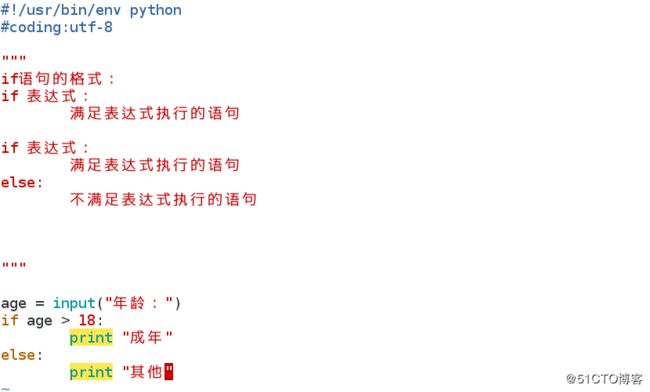
(3)if包含多重条件表达式
[root@localhost code1]# python code1_02_if.py
年龄:12
其他
#2.if包含多重条件表达式
[root@localhost code1]# vim code1_02_if.py![]()
#warn = ""
#if warn:
print "Warning..."
#else:
pint "一切顺利!"
[root@localhost code1]# python code1_02_if.py
一切顺利!

![]()
[root@localhost code1]# vim code1_02_if.py ![]()
warn = ""
dis_uasge = 78
if warn or dis_uasge > 80:
print "服务器急需维护"
else:
print "一切顺利!"
[root@localhost code1]# python code1_02_if.py
一切顺利!![]()
[root@localhost code1]# vim code1_02_if.py ![]()
"""
写一段程序,录入信息包括hostname,ip,used_year,cpu,Memory,manager_name,如果使用>年限超过10年,直接显示警告信息“该服务器使用年限太久!”,如果使用年限不超过10年>,显示该服务器信息如下面的格式:
主机信息
主机名:hostname
IP:ip
使用年限:used_year
CPU:cpu
Memory:Memory
"""
print "****服务器信息录入****"
hostaname = raw_input("主机名:")
IP = raw_input("ip:")
used_year = input("已使用年限:")
if used_year > 10:
print "该服务器使用年限太久!"
else:
CPU = raw_input("cpu类型:")
Memory = input("内存多大:")
print """
主机信息hostname:%s
IP:%s
used_year:%s
CPU:%s
Memory:%s
"""%(hostaname, IP, used_year, CPU, Memory)
[root@localhost code1]# python code1_02_if.py
主机名:localhost.example.com
ip:172.25.254.250
已使用年限:10
cpu类型:i5
内存多大:4000
主机信息hostname:localhost.example.com
IP:172.25.254.250
used_year:10
CPU:i5
Memory:4000
[root@localhost code1]# python code1_02_if.py
****服务器信息录入****
主机名:localhost.example.com
ip:172.25.254.220
已使用年限:20
该服务器使用年限太久!


if和elif
(1)交互式
[root@localhost code1]# ipython
In [1]: age = 10
In [2]: age>10 and age<18
Out[2]: False
In [3]: 10<=age<18
Out[3]: True
if 表达式1:
满足表达式1执行的语句
elif 表达式2:
满足表达式2执行的语句
elif 表达式3:
满足表达式3执行的语句
else:
不满足表达式执行的语句
[root@localhost code1]# vim code1_02_if.py ![]()
"""
1.用户名和密码系统给定
2.用户登录时,输入用户名和秘密,判断是否登陆成功
"""
username = raw_input("用户名:")
password = raw_input("密码:")
if username == "root" and password == "redhat":
print "登陆成功"
else:
print "登陆失败"
[root@localhost code1]# python code1_02_if.py
用户名:root
密码:redhat
登陆成功
[root@localhost code1]# python code1_02_if.py
用户名:root
密码:123
登陆失败
(5)三目运算
a if a>b else b #如果a>b返回a的值,否则返回b的值
In [14]: a = 3
In [15]: b = 4
In [16]: a if a>b else b
Out[16]: 4
[root@localhost code1]# vim code1_02_if.py
num1 = input("第一个数:")
num2 = input("第二个数:")
if num1>num2:
print num1
else:
print num2
[root@localhost code1]# python code1_02_if.py
第一个数:34
第二个数:23
34
[root@localhost code1]# vim code1_02_if.py
num1 = input("第一个数:")
num2 = input("第二个数:")
print num1 if num1>num2 else num2
[root@localhost code1]# python code1_02_if.py
第一个数:23
第二个数:45
45
"""
1.用户名和密码系统给定
2.用户登录时,输入用户名和秘密,判断是否登陆成功
3.用户登陆有三次机会,超过3次还未成功,报错
4.如果用户名密码正确,显示登陆成功,退出程序exit().
"""
6.while循环的语法
(1)while
while 表达式:
满足表达式执行的语句
[root@localhost code1]# vim code1_03_while.py ![]()
count = 0
while count < 10:
print count, #,表示不换行
count += 1
[root@localhost code1]# python code1_03_while.py
0 1 2 3 4 5 6 7 8 9
trycount = 0
while trycount<3:
username = raw_input("用户名:")
password = raw_input("密码:")
if username == "root" and password == "redhat":
print "登陆成功"
exit()
else:
print "登录失败"
trycount += 1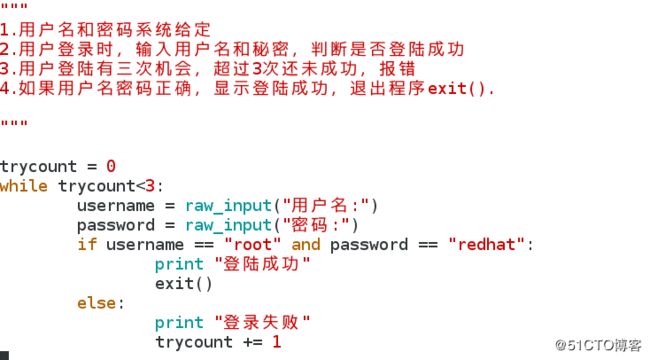
(2)while...else
while 表达式:
满足表达式执行的语句
else:
不满足表达式执行的语句
trycount = 0
while trycount<3:
username = raw_input("用户名:")
password = raw_input("密码:")
if username == "root" and password == "redhat":
print "登陆成功"
exit()
else:
print "登录失败"
trycount += 1
else:
print "超过三次"![]()
[root@localhost code1]# python code1_03_while.py
用户名:123
密码:123
登录失败
用户名:123
密码:123
登录失败
用户名:123
密码:122
登录失败
超过三次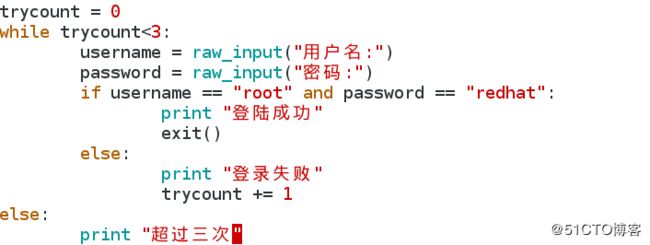
(3)死循环|无限循环
while True:
print "hello"
7.循环语句用户关键字
break:跳出循环,不再进行循环语句
continue:跳出本次循环,继续回到循环语句,执行下一次循环
"""
1.cmd = 显示命令行提示符,等待用户输入;
2.如果命令为空,跳出本次循化,继续接收用户命令;
3.如果命令为quit,跳出所有循化,结束程序;
4.如果有命令,那么打印“run %s” %(cmd)
[root@localhost code1]# vim code1_03_while.py ![]()
"""
while True:
cmd = raw_input("[root@localhost ~]#")
if not cmd:
continue
elif cmd == "quit":
break
elif cmd:
print "run %s" %(cmd)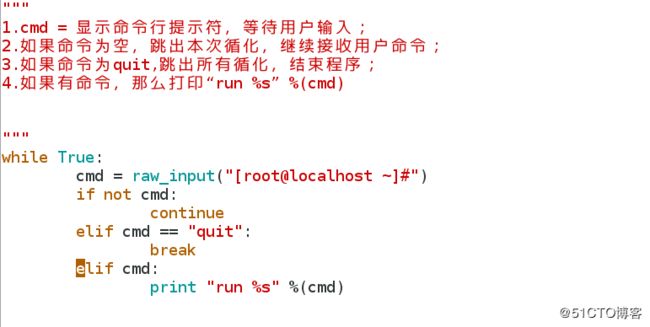
[root@localhost code1]# python code1_03_while.py 
[root@localhost ~]#root
run root
[root@localhost ~]#ls
run ls
[root@localhost ~]#quit
8.for循环
for i in 可迭代的对象:
state1...
第一个可迭代对象:range(start,stop,step)
[root@localhost code1]# python
range(...)
range(stop) -> list of integers
range(start, stop[, step]) -> list of integers
Return a list containing an arithmetic progression of integers.
range(i, j) returns [i, i+1, i+2, ..., j-1]; start (!) defaults to 0.range(2,100,2) #从2开始到99结束,步长为2
[2, 4, 6, 8, 10, 12, 14, 16, 18, 20, 22, 24, 26, 28, 30, 32, 34, 36, 38, 40, 42, 44, 46, 48, 50, 52, 54, 56, 58, 60, 62, 64, 66, 68, 70, 72, 74, 76, 78, 80, 82, 84, 86, 88, 90, 92, 94, 96, 98]
for i in range(1,100,2):
... print i,
...
1 3 5 7 9 11 13 15 17 19 21 23 25 27 29 31 33 35 37 39 41 43 45 47 49 51 53 55 57 59 61 63 65 67 69 71 73 75 77 79 81 83 85 87 89 91 93 95 97 99
In [3]: for i in range(1,6):
...: print i
...: else:
...: print "false"
...:
1
2
3
4
5
false
字符串:
1.创建:单引号,双引号,三引号,转义字符(\n,\t,\",\')
In [4]: a = "hello"
In [5]: type(a)
Out[5]: str
In [6]: b = 'hello'
In [7]: type(b)
Out[7]: str
In [8]: c = """
...: hello
...: world
...: """
In [10]: type(c)
Out[10]: str
转义符号:
一个反斜线加一个单一字符可以表示一个特殊字符,通常是不可打印的字符
\n #换行符 \t #tab符 \" #双引号本身 \' #单引号本身
In [13]: a = "\"hello\""
In [14]: a
Out[14]: '"hello"'
In [16]: a = '"hello"'
In [19]: a
Out[19]: '"hello"'
In [26]: a = "it's \"happy\" day"
In [27]: print a
it's "happy" day
[root@localhost code1]# vim code1_04_for.py ![]()
#!/usr/bin/env python
#coding:utf-8
"""
for循环的语法:
for i in 可迭代对象:
state1...
第一个可迭代对象:range(start,stop,step)
编写九九乘法表:
11=1
12=2 22=4
13=3 23=6 33=9
"""
for i in range(1,10): #i=1;i=2
for j in range(1,i+1): #j=1;j=1,j=2
print "%d%d=%d" %(j,i,ij), #11=1;12=2 22=4
print
[root@localhost code1]# python code1_04_for.py
11=1
12=2 22=4
13=3 23=6 33=9
14=4 24=8 34=12 44=16
15=5 25=10 35=15 45=20 55=25
16=6 26=12 36=18 46=24 56=30 66=36
17=7 27=14 37=21 47=28 57=35 67=42 77=49
18=8 28=16 38=24 48=32 58=40 68=48 78=56 88=64
19=9 29=18 39=27 49=36 59=45 69=54 79=63 89=72 99=81
字符串特征
索引:获取特定偏移元素
给出一个字符串,可输出任意一个字符,如果索引为负数,就是相当于从后向前数。
切片:s[start:stop:step]
start默认值为0,stop默认值为字符串长度减1,step默认值为1
连接操作:
重复操作:
成员操作符:in,not in
索引:
[root@localhost code1]# ipython
n [1]: s = "hello"
In [2]: s[1]
Out[2]: 'e'
In [3]: s[-1]
Out[3]: 'o'
In [4]: s[0]
Out[4]: 'h'
切片:
In [6]: s[1:3:2]
Out[6]: 'e'
重复、连接及计算长度
In [20]: print "hello " + "world"
hello world
In [21]: print ""15 + "学生管理系统" + ""15
学生管理系统
In [23]: print "--"5 + "学生管理系统" + "--"5 #5表示引号中的内容重复5遍,+表示连接
----------学生管理系统---------*-
判断子串是否在字符串中
In [24]: "h" in s
Out[24]: True
In [25]: "lo" in s
Out[25]: True
In [26]: "ho" in s
Out[26]: False
In [27]: 'l' in s
Out[27]: True
In [28]: "ll" not in s
Out[28]: False
字符串常用操作:
- 将字符串首字母大写,并返回新的首字母大写
后的字符串;
In [35]: s = "hello"
In [36]: s.capitalize()
Out[36]: 'Hello'
str.center(width[,fillchar])
- 返回一个长为width的新字符串,在新字符串
中原字符居中,其他部分用fillchar指定的符号填充,
未指定时通过空格填充。
In [39]: s.center(20,'*')
Out[39]: '***hello****'
str.count(sub[, start[, end]]) -> int - 返回sub在str中出现的次数,如果start与end指定,
则返回指定范围内的sub出现次数。
In [40]: s = "i love you"
In [43]: s.count("o")
Out[43]: 2
In [44]: s.count("0",2)
Out[44]: 0
In [45]: s.count("o",2)
Out[45]: 2
In [46]: s.count("o",2,6)
Out[46]: 1
str.endswith(suffix[, start[, end]])
- 判断字符串是否以suffix结束,如果start和end指
定,则返回str中指定范围内str子串是否以suffix结尾,如果
是,返回True;否则返回False
str.startswith(prefix[, start[, end]])
In [49]: s = "i love love you"
In [50]: s.endswith('ou')
Out[50]: True
In [51]: s.endswith('ve',2,10)
Out[51]: False
In [52]: s.endswith('ve',2,10)
Out[52]: False
In [53]: s.endswith('ve',2,11)
Out[53]: True
str.find(sub[,start[,end]])
- 判断sub是否在str中,存在返回索引值,不存在返
回-1.
str.index(sub[,start[,end]]) - 与find方法函数功能相同,如果sub不存在时抛出
ValueError异常;
In [49]: s = "i love love you"
In [55]: s.find("ov")
Out[55]: 3
In [56]: s.find("io")
Out[56]: -1
In [57]: s.find("ov",5,10)
Out[57]: 8
In [1]: s = "i love you"
In [2]: s.index('ov')
Out[2]: 3
In [3]: s.index('rr')
ValueError Traceback (most recent call last)
----> 1 s.index('rr')
ValueError: substring not found


